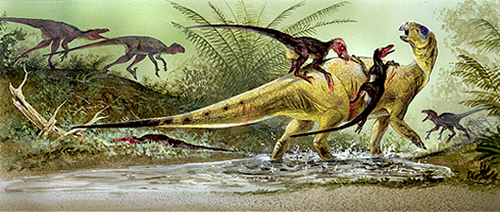|
|
Post by dinosauria101 on Mar 11, 2020 20:33:59 GMT 5
Smilodon fatalis (pride of 2) :origin()/pre00/f9f0/th/pre/i/2015/120/4/5/smilodon_fatalis_fullview_by_dantheman9758-d3dhscv.jpg) t00.deviantart.net/ygSCG0I2fjXhxL6nAUv2Z7k5t6I=/500x250/filters:fixed_height(100 t00.deviantart.net/ygSCG0I2fjXhxL6nAUv2Z7k5t6I=/500x250/filters:fixed_height(100,100):origin()/pre00/f9f0/th/pre/i/2015/120/4/5/smilodon_fatalis_fullview_by_dantheman9758-d3dhscv.jpg Order: Carnivora Family: Felidae Length: 1.8 meters Mass: 220 kg Diet: Large herbivores Age and Location: 34,000-11,000 years ago, Pleistocene epoch, North and South America Weapons: Saber teeth, manual claws Very robust and strong forearms. Is thought to have killed its prey by using its canines to slash the throat. Deinonychus antirrhopus (pack of 6/7)  planetdi.startlogic.com/dinosaur_list/images/deinonychus_pack.jpg planetdi.startlogic.com/dinosaur_list/images/deinonychus_pack.jpgOrder: Theropoda Family: Dromaeosauridae Length: 4 meters Mass: 110 kg Age and Location: 125 million years ago, Early Cretaceous period, United States Diet: Other dinosaurs Weapons: Raptorial jaws, manual and pedal claws One of the most famous of dromaeosaurs. Its fossils gave rise to the theory of pack hunting dinosaurs. |
|
|
|
Post by DonaldCengXiongAzuma on Mar 13, 2020 15:36:50 GMT 5
The deinonychus pack severely outnumbers the smilodon fatalis coalition. Mismatch in favour of the deinonychus pack.
|
|
|
|
Post by dinosauria101 on Mar 13, 2020 17:21:42 GMT 5
Likely not a slaughter, but I'd give this to the Deinonychus pack too. More numerous, likely superior jaws and claws, and much better stamina - all those would help.
|
|
|
|
Post by Infinity Blade on Mar 13, 2020 17:29:03 GMT 5
How does Deinonychus have superior jaws to a (according to your own word) twice as heavy* predator with what basically amount to 18 cm knives for teeth?
*I still doubt 110 kg for Deinonychus, so Smilodon could very well be even heavier compared to an individual Deinonychus.
|
|
|
|
Post by dinosauria101 on Mar 13, 2020 17:36:44 GMT 5
^I was referring to 2 things when I said that - maybe I should specify. 'Superior jaws' meant proportionately larger head and not precision oriented, while 110 kg was from this paper, which was AFAIK still considered up to date when brought up in the Deinonychus vs mountain lion thread: besjournals.onlinelibrary.wiley.com/doi/full/10.1111/2041-210X.12226 |
|
|
|
Post by Infinity Blade on Mar 13, 2020 18:24:45 GMT 5
It being proportionately larger has more limited meaning here given how an individual Smilodon is much heavier than an individual Deinonychus. Sabertooths have probably also attacked areas such as the ribs ( link->), and as we should all now know, the skull, in addition to the usual throat bite against prey, so the "precision oriented" thing is a little moot (all the more so against a much smaller Deinonychus). Yeah I know. I have questioned that estimate before. See the last few posts on page 7 and the first post on page 8 of the "theropod non-locomotory limb function" thread. theworldofanimals.proboards.com/thread/464/theropod-non-locomotory-limb-function?page=7 |
|
|
|
Post by dinosauria101 on Mar 13, 2020 18:36:59 GMT 5
Hm. You do have good points both ways.
It's probably a bit closer than I thought if Deinonychus is 70-80 kg instead of 110. Might depend on how many Deinonychus the Smilodon can quickly kill; if they can kill a few at the start, they'd likely win, but if not that would give the dinosaurs a chance to tire and attack them. May lean SLIGHTLY twoards the Deinos due to numbers and stamina, but mostly on the fence atm.
|
|
|
|
Post by 6f5e4d on Mar 15, 2020 0:55:31 GMT 5
The Deinonychus vastly outnumber and outweigh the Smilodon in this case. And with sharper teeth and claws they can win.
|
|